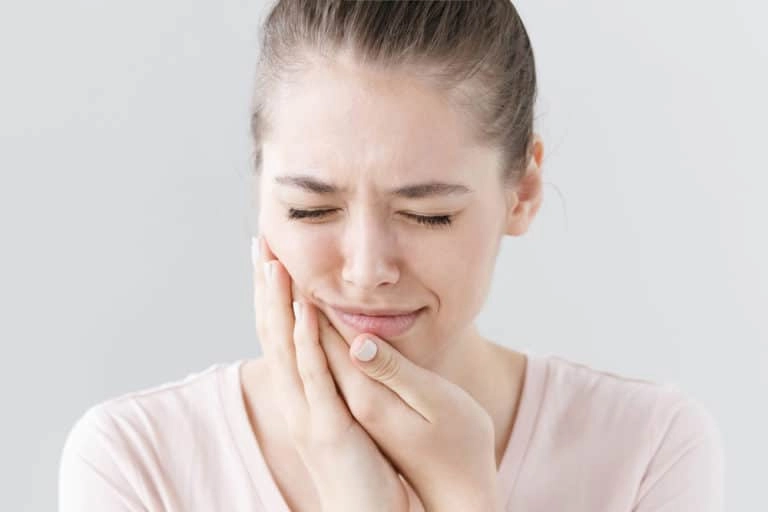TMJ can make it hard or painful to chew, yawn, or even talk. And it’s an issue that many people suffer from at some point in their lives. But chiropractic care can help you get quick relief from TMJ.
TMJ is a term for inflammation of the temporomandibular joint, which connects your jaw to your skull. Since it’s part of the musculoskeletal system, chiropractors are well-versed in treating it with various chiropractic modalities including soft tissue work and a TMJ adjustment. Many patients experience relief after one session.
How to Tell if You Have TMJ?
While jaw pain is one symptom of TMJ (also known as TMD), there are many other things that can cause jaw pain. So, to help you determine if you do, in fact, have TMJ, check this list of common symptoms:
- Trouble or pain when chewing
- Popping or cracking when opening or closing the jaw
- Headaches or pain in the facial muscles
- Pain in the neck, shoulders, or teeth
- Locking jaw
- Overexerted facial muscles
- Dizziness or ringing in the ears
TMJ Chiropractor or Dentist?
Once you have identified TMJ with symptoms from the list above, you may be wondering if you should see a dentist or a chiropractor. This is a common concern and one that doesn’t have an overall answer. It depends.
If your TMJ is caused by grinding your teeth while you sleep, or if you’re having pain issues with your teeth, you may want to see a dentist first.
If your TMJ pain is accompanied by joint or muscle pain in the jaw, or you’re suffering from neck or back pain, you should probably see a licensed chiropractor.
In some cases, you may need to see a dentist to get a mouth guard for sleeping and a chiropractor for relief from the joint issues.
How Does a Chiropractor Treat TMJ?
You may be surprised at how intertwined the jaw and the rest of the body are. A study done in 2007 found that when participants had a specially-designed insert in their mouths preventing their teeth from assuming the proper position, they had trouble maintaining bodily balance.
The same study found that, when participants wore a heel lift under one foot, their teeth would meet first on the side of the body with the heel lift. This outlines the complex relationship between body posture and jaw function.
Once you know this, it’s not hard to see why chiropractors are in an ideal position to help treat TMJ, and why their scope of practice is so wide.
Chiropractic Jaw Adjustment
One of the ways chiropractors treat TMJ is by performing a jaw adjustment. Although this may vary from patient to patient, below is an example of the assessment and adjustment for TMJ.
- The doctor of chiropractic will have you open and close your jaw while feeling each side by placing his or her fingers on each side of the jaw.
- The chiropractor determines which side of the jaw opens first and widest, and which side opens last and least.
- Once this is determined the chiropractor will likely perform a jaw adjustment with his or her hands by applying gentle pressure to the “last and least” side of the jaw.
- Many patients see improvement after this adjustment, but the doctor of chiropractic may want to perform other techniques, as well.
Soft Tissue Manipulation
Much of the time the issues with jaw pain lies in the muscles that allow the jaw to open and close. If this is the case, the chiropractor will perform soft tissue manipulation on these muscles to loosen them up and allow the jaw to even out. This is one way that a chiropractor helps with headaches associated with jaw pain of TMJ.
The chiropractor will focus on three key muscles:
- Masseter
- Temporalis
- Pterygoid
He or she will move through these muscles in turn, using his or her fingers to apply pressure to these muscles repeatedly as you open and close your mouth. These can be a little uncomfortable for many patients, which is to be expected.
TMJ Therapy
Another way the chiropractors help with TMJ is by using different therapies. Most often with TMJ, these include cold therapy and laser therapy. These can help relieve pain, reduce inflammation, and promote tissue healing.On your first visit to the chiropractor for TMJ, the doctor may give you exercises to perform at home to help you heal and get back to normal.

Chiropractic TMJ Exercises
These simple exercises are easy to do at home or at work to help you relieve your TMJ pain and prevent it from happening again.
1) The Goldfish
- Gently press your tongue against the roof of your mouth.
- Press the index finger of one hand near your ear where your TMJ is located (you should be able to feel it when opening your mouth).
- Place the index finger of your other hand on your chin.
- Let your jaw come open halfway and then close it.
- Repeat 6 times in one set and perform each set 6 times a day.
You can also do a variation of this by opening your mouth fully instead of halfway. Whichever version you choose, you should feel a little resistance but no pain during the exercise.
2) Resistance Mouth Opening
- Place the pad of one thumb under your chin.
- Open your mouth while gently pushing against it with your thumb.
- Hold for 5 to 8 seconds then close your mouth.
- Repeat a few times throughout the day.
3) Resistance Mouth Closing
- With your mouth open, hold onto your chin with the index finger and thumb of both hands.
- Close your jaw while gently providing resistance with your fingers.
- Hold for 5 to 8 seconds.
- Repeat a few times throughout the day.
4) Lateral Jaw Movement
- Place a thin object between your front teeth, such as a pencil or pen.
- Lightly gripping the object, move your jaw from side to side 12 to 15 times.
- Increase the size of the object as the exercise gets easier.
You can also perform this exercise with forward movement, instead of lateral movement.
5) Tongue Opening
- With your mouth closed, place the tip of your tongue on the roof of your mouth.
- Keeping your tongue to the roof of your mouth, open and close your jaw.
- Repeat 8 to 10 times per set, 3 to 5 sets per day.
Can Chiropractors Treat TMJ?
As you can see, chiropractors are in an ideal position to treat TMJ. They perform jaw adjustments, soft tissue therapy, and may use cold or laser therapy, as well. In some cases, depending on the cause of the TMJ, your chiropractor may work with your dentist to ensure you have the best treatment possible.
A dentist can provide a mouth guard for those who grind their teeth at night while a chiropractor can relieve pain, loosen muscles, and provide you with exercises to strengthen the jaw muscles. On the whole, TMJ is a common occurrence, but it can be remedied quickly by chiropractic care.
Resources:
https://www.nidcr.nih.gov/health-info/tmj
https://www.tandfonline.com/doi/abs/10.1179/crn.2007.037
https://www.healthline.com/health/tmj-exercises#other-treatments









